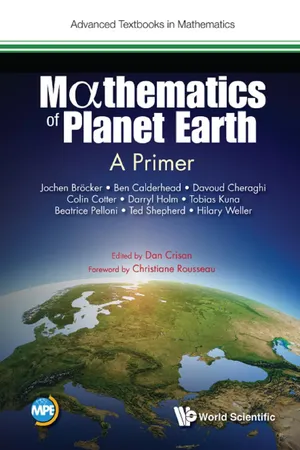
Mathematics of Planet Earth
A Primer
- 372 pages
- English
- ePUB (mobile friendly)
- Available on iOS & Android
Mathematics of Planet Earth
A Primer
About this book
-->
Mathematics of Planet Earth (MPE) was started and continues to be consolidated as a collaboration of mathematical science organisations around the world. These organisations work together to tackle global environmental, social and economic problems using mathematics.
This textbook introduces the fundamental topics of MPE to advanced undergraduate and graduate students in mathematics, physics and engineering while explaining their modern usages and operational connections. In particular, it discusses the links between partial differential equations, data assimilation, dynamical systems, mathematical modelling and numerical simulations and applies them to insightful examples.
The text also complements advanced courses in geophysical fluid dynamics (GFD) for meteorology, atmospheric science and oceanography. It links the fundamental scientific topics of GFD with their potential usage in applications of climate change and weather variability. The immediacy of examples provides an excellent introduction for experienced researchers interested in learning the scope and primary concepts of MPE.
-->
Request Inspection Copy
--> Contents:
- Foreword
- Introduction
- The General Circulation of the Atmosphere and Oceans (Theodore G Shepherd)
- Partial Differential Equations (Beatrice Pelloni and Darryl Holm)
- Data and Probability (Jochen Bröcker and Ben Calderhead)
- Dynamical Systems (Davoud Cheraghi and Tobias Kuna)
- Numerical Methods (Colin Cotter and Hilary Weller)
- Bibliography
- Index
-->
--> Readership: Advanced undergraduate and graduate students in mathematics, physics and engineering; advanced students of geophysical fluid dynamics (GFD) for meteorology, atmospheric science and oceanography. -->
Mathematics of Planet Earth;Partial Differential Equations;Data Assimilation;Dynamical Systems;Mathematical Modelling;Numerical Simulations;Geophysical Fluid Dynamics;GFD0
Frequently asked questions
- Essential is ideal for learners and professionals who enjoy exploring a wide range of subjects. Access the Essential Library with 800,000+ trusted titles and best-sellers across business, personal growth, and the humanities. Includes unlimited reading time and Standard Read Aloud voice.
- Complete: Perfect for advanced learners and researchers needing full, unrestricted access. Unlock 1.4M+ books across hundreds of subjects, including academic and specialized titles. The Complete Plan also includes advanced features like Premium Read Aloud and Research Assistant.
Please note we cannot support devices running on iOS 13 and Android 7 or earlier. Learn more about using the app.
Information
Chapter 1
The General Circulation of the Atmosphere and Oceans
1.1 Introduction
1.2 Zonally Integrated View of Atmospheric and Oceanic Circulation
1.2.1 Energy balance


Table of contents
- Cover page
- Title page
- Copyright
- Foreword
- Introduction
- Contents
- 1. The General Circulation of the Atmosphere and Oceans
- 2. Partial Differential Equations
- 3. Data and Probability
- 4. Dynamical Systems
- 5. Numerical Methods
- Bibliography
- Index